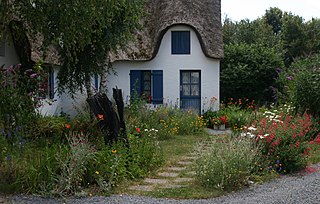
A wildlife garden is an environment created with the purpose to serve as a sustainable haven for surrounding wildlife. Wildlife gardens contain a variety of habitats that cater to native and local plants, birds, amphibians, reptiles, insects, mammals and so on, and are meant to sustain locally native flora and fauna. Other names this type of gardening goes by can vary, prominent ones being habitat, ecology, and conservation gardening.

A bathroom, restroom or washroom is a room, typically in a home or other residential building, that contains either a bathtub or a shower. The inclusion of a sink is common. In parts of the world e.g. India, a toilet is typically included in the bathroom; in others, the toilet is typically given a dedicated room separate from the one allocated for personal hygiene activities. In the United States and Canada, the word "bathroom" is often used to refer to any room that contains a toilet, regardless of the inclusion of a bath or shower.

The bluebirds are a North American group of medium-sized, mostly insectivorous or omnivorous birds in the order of Passerines in the genus Sialia of the thrush family (Turdidae). Bluebirds are one of the few thrush genera in the Americas.

The white-faced heron also known as the white-fronted heron, and incorrectly as the grey heron, or blue crane, is a common bird throughout most of Australasia, including New Guinea, the islands of Torres Strait, Indonesia, New Zealand, and all but the driest areas of Australia.

Water garden or aquatic garden, is a term sometimes used for gardens, or parts of gardens, where any type of water feature is a principal or dominant element. The primary focus is on plants, but they will sometimes also house waterfowl, or ornamental fish, in which case it may be called a fish pond. They vary enormously in size and style.
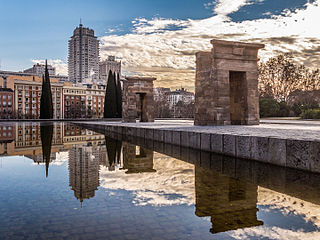
A reflecting pool, also called a reflection pool, is a water feature found in gardens, parks and memorial sites. It usually consists of a shallow pool of water with a reflective surface, undisturbed by fountain jets.

A birdfeeder, bird table, or tray feeder is a device placed outdoors to supply bird food to birds. The success of a bird feeder in attracting birds depends upon its placement and the kinds of foods offered, as different species have different preferences.

The yellow perch, commonly referred to as perch, striped perch or preacher is a freshwater perciform fish native to much of North America. The yellow perch was described in 1814 by Samuel Latham Mitchill from New York. It is closely related, and morphologically similar to the European perch ; and is sometimes considered a subspecies of its European counterpart.
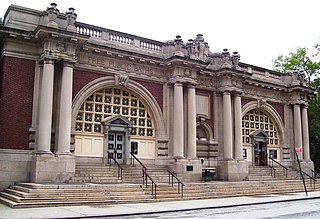
Public baths originated when most people in population centers did not have access to private bathing facilities. Though termed "public", they have often been restricted according to gender, religious affiliation, personal membership, and other criteria.

A spa is a location where mineral-rich spring water is used to give medicinal baths. Spa towns or spa resorts typically offer various health treatments, which are also known as balneotherapy. The belief in the curative powers of mineral waters goes back to prehistoric times. Such practices have been popular worldwide, but are especially widespread in Europe and Japan. Day spas and medspas are also quite popular, and offer various personal care treatments.

Saginaw Bay is a bay within Lake Huron located on the eastern side of the U.S. state of Michigan. It forms the space between Michigan's Thumb region and the rest of the Lower Peninsula of Michigan. Saginaw Bay is 1,143 square miles (2,960 km2) in area. It is located in parts of five Michigan counties: Arenac, Bay, Huron, Iosco, and Tuscola.
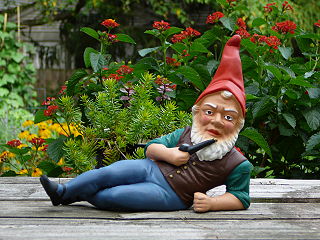
A garden ornament or lawn ornament is a non-plant item used for garden, landscape, and park enhancement and decoration.

A puddle is a small accumulation of liquid, usually water, on a surface. It can form either by pooling in a depression on the surface, or by surface tension upon a flat surface. Puddles are often characterized by murky water or mud due to the disturbance and dissolving of surrounding sediment, primarily due to precipitation.

A garden pond is a water feature constructed in a water garden or designed landscape, normally for aesthetic purposes, to provide wildlife habitat, or for swimming.

The Backyard Wildlife Habitat is a program of the National Wildlife Federation that encourages homeowners in the United States to manage their gardens and yards as a wildlife garden, with the goal of maintaining healthy and diverse animal habitats and ecosystems. The program began in 1973. By 1998, it had impacted more than 21,000 yards and, as of 2006, has certified over 60,000 'backyards'.
Root rot is a condition in which anoxic conditions in the soil or potting media around the roots of a plant cause them to rot. This occurs due to excessive standing water around the roots. It is found in both indoor and outdoor plants, although it is more common in indoor plants due to overwatering, heavy potting media, or containers with poor drainage. The leaves of plants experiencing root rot often yellow and die, and if allowed to continue, the condition can be fatal.
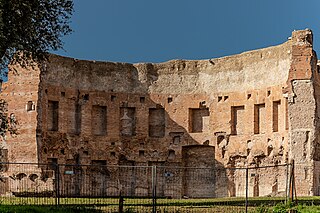
Bathing played a major part in ancient Roman culture and society. It was one of the most common daily activities and was practised across a wide variety of social classes. Though many contemporary cultures see bathing as a very private activity conducted in the home, bathing in Rome was a communal activity. While the extremely wealthy could afford bathing facilities in their homes, private baths were very uncommon, and most people bathed in the communal baths (thermae). In some ways, these resembled modern-day destination spas as there were facilities for a variety of activities from exercising to sunbathing to swimming and massage.

Birdbath, constructed of fieldstone and concrete, is an early 20th-century decorative feature on the historic Oldfields estate on the campus of the Indianapolis Museum of Art (IMA), in Indianapolis, Indiana. It is now an accessioned work of art in the collection of the IMA.

Greek baths were bath complexes suitable for bathing and cleaning in ancient Greece, similar in concept to that of the Roman baths. Greek baths are a feature of some Hellenized countries. These baths have been found in Greece, Egypt, Italy, and there is even one located in Marseille, France. Some of the first baths have been dated back to the 5th century BCE. The public baths had a gradual development into the flourishing, culturally-significant structures of the Hellenistic age. The multiple locations of the baths throughout the Mediterranean offer different, culturally-unique developments.

The Stabian Baths are an ancient Roman bathing complex in Pompeii, Italy, the oldest and the largest of the 5 public baths in the city. Their original construction dates back to ca. 125 BC, making them one of the oldest bathing complexes known from the ancient world. They were remodelled and enlarged many times up to the eruption of Vesuvius in 79 AD.
























